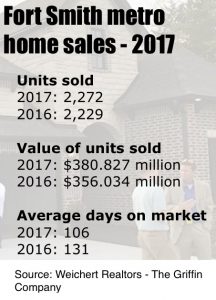Fort Smith metro home sales finish 2017 with 7% gain
by January 15, 2018 4:08 pm 390 views

The Fort Smith metro home sales market — Crawford, Sebastian counties — finished 2017 with positive numbers across every indicator, topping $380.827 million in sales volume with 2,272 units moved compared to $356.034 million on 2,229 units in 2016 — gains of 6.96% and 1.93%, respectively.
For the month, gains were more significant at 19.25% as the combined market posted $34.405 million in sales against $28.851 million in December 2016. Units sold improved slightly as well to 191 against 183, a 4.37% increase.
Sebastian County — home to Fort Smith, the region’s largest city and second largest in Arkansas — drove most of the growth for the last 365, posting $275.116 million in sales against $262.53 million in 2016, an increase of 4.79%. For the month, the county did $24.543 million compared to $20.22 million the previous year, a 21.38% gain. Units sold inched up to 1,571 from 1,558, an increase of 0.83% for the year. One hundred thirty-one of those units moved in December, a jump of 9.17% from December 2016’s 120.
Meanwhile, Kevin King and Jonella Graham of Weichert Realtors – The Griffin Company note, the time that it took to sell a home fell sharply to just 106 days for the year from 131 for 2016 (a 19.08% decrease). Average sales prices rose for the month to $163,983 from $130,026, bringing year-to-date averages to $155,466 from $148,179, a 4.92% jump.
Crawford County enjoyed larger percentage gains but a smaller piece of the regional volume with $105.711 million in 2017 sales versus $93.504 million in 2016, a double-digit increase of 13.06%. The county also moved 701 units against 671 the previous year, an increase of 4.47%.
For the month, the gains were slightly higher with $9.862 million in sales versus $8.631 million in December 2016, an increase of 14.26%, while units sold were 60 against 63 the previous year, a decline of 4.76%. As with Sebastian County, Crawford County homes took much less time to sell with just 111 days on the market for the year against 130 the previous year, a 14.62% drop in wait times. Average sales prices hit $142,387 for the month against December 2016’s $125,615, bringing the year to a close with an average of $131,668 versus $125,454, a gain of 13.35%.

“Attempts were made to make rental income for landlords taxable at normal income rates but that move failed, fortunately for rental owners,” Graham stated.
Real estate-wise, the law “retains the current-law maximum rates on net capital gains (generally, a 15% maximum rate, but 20% for those in the highest tax bracket and a 25% rate on “recapture” of depreciation from real property).”
Also, the mortgage interest deduction has been reduced to $750,000 for new loans taken out after Dec. 14, 2017, and current loans of up to $1 million will be grandfathered in.
“The other biggie is that the deduction for interest paid on home equity debt will be repealed through Dec. 31, 2025. The interest will still be deductible on home equity loans (second mortgages) if the proceeds are used to substantially improve the residence,” King said. “The accountants and tax attorneys appear to agree on one major theme of the tax reform, and that is that most people will benefit from one part and won’t benefit from another, but when you add it all up, the average taxpayer will see a modest difference at the end of the year.”
